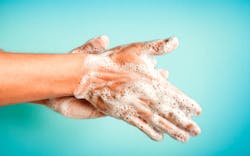Humidity and Health: COVID-19 Answers Still Elusive
In January, I wrote about the research from the Baylor University College of Medicine and the University of Arizona, in which the researchers concluded that maintaining 30 to 60 percent RH in offices reduces occupant stress and improves sleep quality. What I neglected to add, is that it has been well-known for some time that higher humidity levels can reduce the activity of the flu virus.
In a 2013 study from the Centers for Disease Control and Prevention (CDC), scientists found that at relative humidity (RH) levels of 23 percent, 70 to 77 percent of the flu viruses were still able to cause an infection an hour after they were released into the air. At an RH of 43 percent, only 14 percent of the viruses caused infection. Apparently, most of the flu viruses are inactivated after only 15 minutes in the more humid air. Prior to that study, scientists recognized that RH affected flu transmission, offering a possible explanation as to why flu infections decrease during summer months. The new study considered how higher indoor RH in healthcare facilities during the summer reduced flu transmission.
So, today, with the so-called coronavirus (actually 2019-nCoV or COVID-19) threat, one would think that those of us in locales with higher RH, like South Florida, would be better off than our brethren in drier air locations. However, according to Dr. Gunter Kampf of Greifswald University Hospital in Germany, “Low temperature and high air humidity further increases their [coronaviruses] life span”.
Since not much is known about COVID-19 specifically, researchers at the CDC have been reviewing the literature on the entire family of these viruses and have determined that they can remain infectious, at typical room temperature, for up to nine days. However, before I change any thermostat or humidistat settings, I’m going to follow the CDC’s advice and wash my hands more frequently, with soap and water and hand sanitizer.
************
While we’re on the subject of coronavirus, “What Coronavirus Teaches Us About Climate Change” is a new article by environmental journalist and New York magazine deputy editor David Wallace-Wells. He is perhaps best known for writing “The Uninhabitable Earth”. But before you panic, note that 17 scientists reviewed the article and determined that its scientific credibility was low. In fact, Prof. Michael Mann, of the Penn State University meteorology department, described the article as “overly bleak”, containing erroneous statements, and in some cases “just not true”.
That said, his recent article starts by reminding us of the amount of global warming being experienced, and the effects that is having. He specifically cites such phenomena as Antarctic temperatures exceeding those in San Diego, ice sheet melting, and the Australian bushfires. Wallace-Wells then goes on to discuss the emphasis by thought leaders and policymakers to shift priorities from mitigation to adaptation, something I also touched on a year-and-a-half ago here. His article concludes with a comparison of the responses to climate change and coronavirus, as he points out that mitigation – avoiding the virus in the first place – is much preferred over adaptation strategies like quarantine.
My recommendation? For now, it's still to wash your hands!
A regular contributor to HPAC Engineering and a member of its editorial advisory board, the author is a principal at Sustainable Performance Solutions LLC, a south Florida-based engineering firm focusing on energy and sustainability. Contact him at [email protected].
